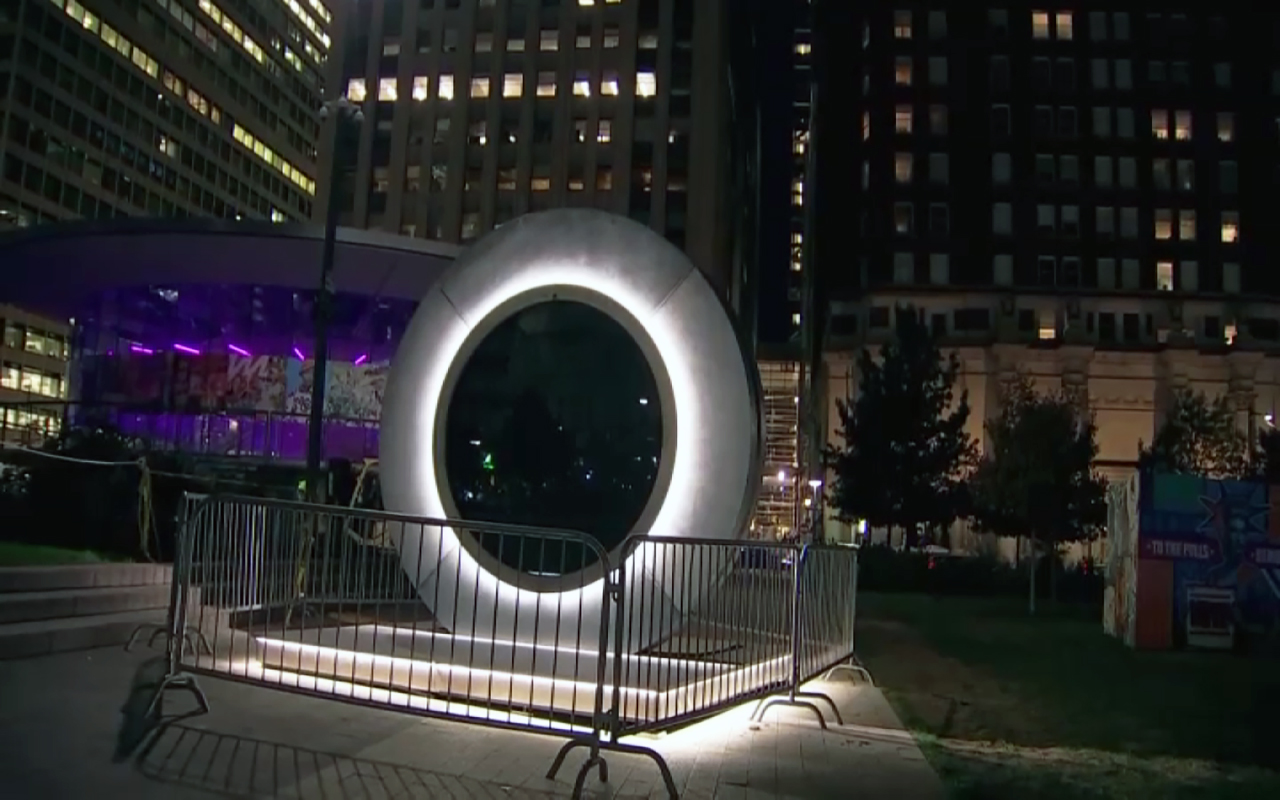
South 9th Street BID defeated, and "it's about time to get organized"
A plan to create a Business Improvement District in the Italian Market area, where Mexican businesses revitalized once-abandoned storefronts, has been shelved…
Walk down 9th Street from Center City and you’ll see. Past South Street, the crowds fall away for awhile. Cars traveling north from the city’s industrial depths play chicken with the cross-traffic, and the street-facing windows are still lives of electric candles, figurines of saints, and sleeping cats, framed in brick. As you move south towards the Italian Market, cracks bloom in the pavement. The produce stands take orders in Spanish. Green, white and red are Mexico’s colors, too.
Neighborhood change takes time to become visible. The empty lot between Washington Avenue and Ellsworth Street, for example, still serves mostly as a reminder of the ice factory that used to sit there and the changes its closure represents. But the lot is owned by Midwood Management, a development corporation from New York which hopes to turn into a 70-apartment complex, complete with its own commercial center and underground parking.
Michelle Gambino, business manager of the South 9th Street Business Association, is confident about all of these changes.
“We’ve been doing the same thing for over a hundred years: welcoming immigrants, immigrants opening up businesses, people coming down here to shop,” she says. “This area has always been an area of immigrants and it continues to be an area of immigrants. And that’s what makes it really special.”
In that specialness, Gambino sees the potential for progress. The Italian Market is less than two miles from City Hall, but it’s been neglected. The streets are constantly swirling with trash, parking is difficult to find, and immigrant-owned businesses don’t have the resources to advertise themselves outside the neighborhood. Since cutting municipal services, the closest the city might come to helping is through the Council-approved creation of a Business Improvement District (BID), essentially an independent, locally-controlled taxing authority which “assesses” all businesses in its borders based on their property value. The funds collected would then be distributed for the common good.
Gambino’s association won a city grant to plan a BID in 2013. The planning process requires a thorough assessment of the community’s needs. The South 9th Street Business Association hired a consultant and held nine public meetings. At most of these, bilingual interpreters were on standby, a gesture of inclusion for the immigrants Gambino recognizes as the heart of the neighborhood.
Yet inclusion couldn’t be more than a gesture, because the state laws which structure Philadelphia’s BID system exclude recent immigrants by their very design. The city’s Commerce Department doesn’t keep specific statistics about minority-owned businesses on South 9th Street, but locals estimate that at least half are owned by Mexicans. For various reasons, chief among them the near-impossibility of getting a mortgage without legal immigration status, almost none of the Mexican business operators also own their storefronts. And legally, the only stakeholders enfranchised by a BID are building owners. That means that almost no Mexican businesses count as part of the “community” whose interests the BID seeks to advance.
This October, the BID’s official stakeholders, including a core opposition comprised of Italian old-timers, voted it down for their own reasons. According to Gambino, the BID manager’s proposed $60,000 salary, low compared to others around the city but exorbitant compared to average business revenue in the Italian Market, was a bone of contention. Interviews in PlanPhilly and the Philly Voice also suggest that the building owners don’t see the sense in chipping in more money now that the Italian Market is the cleanest and most vibrant it’s been in years.
It’s true that the neighborhood has changed drastically since the year 2000, when it was declared “in ruins” by the City Planning Commission with 33 of 76 surveyed properties reported vacant.
“Back in the day, if you wanted to go to Pat’s and Geno’s, it was a gauntlet to get from 9th & Washington to 9th & Wharton,” says Karenina Wolff, an immigration lawyer and co-founder of the South Philadelphia Latino Business Community. “It was scary. You can just sort of imagine darkness. And that’s why the companies called it “Steak Vegas,” that’s why they have those big crazy lights. It’s because of the Mexican business owners that it’s not scary to walk to Pat’s and Geno’s anymore.”
But the Mexicans aren’t the only ones who’ve moved in since then.
“Not so far back, five years ago, the rents in this area were more or less $800, $1000 for a very good house,” says Armando Aparicio, who upon his arrival in 1996 paid just $500 a month to live on Lombard Street in Center City. As the map above shows, South Philly has since experienced a steady influx of highly-educated, highly-compensated people, many of them white.
“Right now [housing] rents are at $1500, $2000 in this same area. Now the community is moving further south, and to West and Northeast. So it’s opening up...the people have to divide themselves.”
Aparicio owns a restaurant called El Sarape, which you’ll find continuing down South 9th Street out of the Italian Market, just past Pat’s and Geno’s. It sits outside the proposed 9th Street BID boundaries, but Aparicio is an important figure in the Mexican community’s debate on the issue, being himself a gentrification refugee—or, if progress is progress, a poor surfer of the tides of change. Three years ago, he moved to the block after being priced out from a prime location in the nearby East Passyunk Avenue BID.
El Sarape’s new location is still within the bounds of the EPABID, but its distance from the more visible commercial center means that it enjoys few of the associated benefits. The best-known Mexican restaurant within its borders is Cantina Los Caballitos, which isn’t even owned by Mexicans. Sam Sherman, a developer who directed the BID starting in 2010, won praise for recruiting gourmet chefs from around the country and subsidizing their rents, creating what’s now known as “Restaurant Row.” But for everyone else, says Aparicio, the BID just “raises prices, raises rents, raises taxes. And for those who don’t have a long lease—well, a lease that’s at least five years—it doesn’t help you at all. If your lease is just one year, or due to expire soon, renew now before the owners realize or you’ll be stuck paying more.”
Since El Sarape gets less foot traffic in its new location, Aparicio has been finding other sources of business. He got a spot as a vendor at the baseball stadium for the first time this year, where his is the only Mexican food stand. He also markets El Sarape as a party venue to members of the community, many of whom have extended family networks in the neighborhood but live in rowhomes with little space for dancing.
“I do events for all Latinos, wherever they’re from, with 50, 60 people,” Aparicio says. “It goes well. They’re parties for birthdays, baptisms, quinceañeras—anything special. A divorce. They celebrate a friend who’s going to Mexico, to El Salvador, someone going to Honduras...They’re parties that the community invents for itself.”
I ask Aparicio if he can get me into one of his parties, and he says yes right away. That Saturday, a Mexican couple, Gisela and Genaro, are throwing a joint birthday celebration for two of their three children.
The first honoree is an eight-year-old girl in a yellow princess dress and gem tiara. The second just turned two and is eating carnitas from the plate of his thirteen-year-old brother, who chats with a school friend in English.

Conversations around the room are quiet and unhurried. Banda music blares from a standing speaker, and the kids are playing tag. From the looks of things, I am the only foreigner present.
“Racism is the neighborhood’s biggest social problem,” Gisela, the mother explains to me. Her eldest son is on a soccer team that plays further south, towards Oregon Ave. That neighborhood is more black and white, and there have been incidents. “The kids don’t like how many Hispanics are in the league. They say we don’t have much right to be here.”
Gisela’s husband Genaro works in an Italian-owned business further up South 9th Street and has never heard of the BID. Except for his boss, his coworkers are Mexicans from Puebla and Tlaxcala.
“We get along the ways we know how,” he says in response to my question about his work environment. “The culture almost doesn’t change. We feel good—we’re not prohibited from speaking our language.”
These kinds of safe spaces can thrive most easily with the community close. Yet as Aparicio has pointed out, rising rents threaten to disperse its members throughout the city. The solution? As of yet, no one’s landed on it. But the people who are most concerned are trying to get organized.
“We have a voice, but we don’t have a vote,” says Juan Carlos Romero. He was one of the original owners of Los Taquitos de Puebla, and just moved his new venture, Philly Tacos, to Point Breeze. He sits on the executive board of Juntos and, despite personal doubts, was on the BID steering committee. He also helped to found the South Philly Latino Business Community (SPLBC) with Karenina Wolff. We meet up the day after the BID’s withdrawal in City Council for an interview.
“It’s about time to get organized,” he says. “It’s about time to begin to have economic power. I believe that we’re already beginning to have it. But we have to organize ourselves so that we’re able to channel our economic power.”
We walk south from Fleisher Art Memorial, where Romero also serves on the planning committee for Día de los Muertos. He seems to know everyone, greeting those we pass by asking if they’ll come to Fleisher’s procession on November 1. It irks him that the Mexican community in South Philly must so often leave the neighborhood to celebrate its most important holidays. This is the first year that the Fleisher celebration will include a parade through the Italian Market area.
“We need the support of the community, their presence, to continue teaching our traditions,” he says emphatically.
In the past, Romero has made a project of this conviction by planning holiday festivals throughout the year. More recently, he’s been hard at work opening a new taco shop in Point Breeze where the market for Mexican food is less saturated. Romero hopes that someday the SPLBC will be equipped to do things like keep track of the number of Mexican restaurants per neighborhood and take charge of planning the Independence Day festival —which, without his help this year, simply didn’t happen.
“On September 15, this street was dead,” he says. “This area is Hispanic!”
The biggest party and by extension, the biggest investments took place in Penn’s Landing, where PECO sponsored a festival hosted by the Mexican Consulate and the Mexican Cultural Center. Romero would’ve liked to see some of that money stay in the neighborhood. Once drawn to the Italian Market area for a party, he believes, “the people will keep coming back.”
But party planning at the city level takes money, know-how, and the approval of the South 9th Street Business Association. After an uncomfortable misunderstanding last spring when the Greater Philadelphia Hispanic Chamber of Commerce tried to fund a Cinco de Mayo festival without first checking with Michele Gambino, everyone seems nervous to try again.
This specific nervousness is just one instance of the pervasive nervousness of breaking an unknown rule, which is omnipresent for Mexicans in the Italian Market. It complicates collaborations, sours trust, and widens distance, but it’s rooted in an isolating legal reality: even small-scale interactions with law enforcement, like paying a parking ticket, can be freighted with risk for undocumented people.
A few years ago, the city installed temporary parking signs on the alleyways off 9th Street, trying to discourage residents from filling spaces that might otherwise host customers. And whereas beforehand, the weekend streets would bustle with Latino shoppers from Camden and Norristown, now Mexican merchants have noticed a significant drop in business.
“It makes people have doubts,” says Isabel Espinosa, proprietor of a clothing and candle shop below Washington Avenue. “Checking, checking, checking, already worried. They don’t buy their things in peace.”

The back room of Espinosa’s shop features two pastel clouds worth of imported party dresses from Mexico City; the front, a host of everyday objects imprinted with the Virgen de Guadalupe. Things, in other words, designed to appeal to Mexicans. But, says Espinosa, “I would be pleased if the community receiving us were busier, more mixed.” According to her, the t-shirts with the Virgen have crossover appeal.
Several doors down, Sixto Sosa has been running King DVD and Video Games since 2010. When Romero and I ask him what he thinks of the BID’s recent defeat, he tells us this is the first he’s heard of it. He doesn’t own his building and wasn’t following the planning process closely. “Sure, they passed by to leave flyers, but I didn’t really pay attention,” he says.
Sosa was brought to the United States as a child and grew up in New York City. Like Romero, he’d like to see the community better consolidate its economic power by making long-term investments in the neighborhood. But he says most adults he knows don’t tend to see things that way. “They keep thinking that they’re going to go home,” he explains.
And underlying this hope of a freely-chosen return is the parallel worry of being forced to leave at any moment.
“You can have money in your hands, and you say to yourself that no, they’re going to deport me,” Sosa explains. “The community already has the money, but it continues to live in fear.”
Sosa and Espinosa both tell Romero that they hope he’ll keep organizing, and he thanks them, promising to keep them in the loop. He looks exhilarated. But back on the street, he qualifies his excitement. The work ahead will be long and difficult.

“Sometimes, we’ll spend up to three hours talking to a businessperson to explain to them what our objective is,” he says, “in terms of apples and pears, making them know. Lots of people don’t have the time. And when you don’t have the support of the people, it’s frustrating...We lose more by missing a meeting than by leaving our stores for an hour.”
Even now, there’s no shortage of organizations which wish to offer their services to the Mexican community of the Italian Market. The problem is that business is among the most complicated and layered of the challenges it faces.
The Greater Philadelphia Hispanic Chamber of Commerce, currently based in Center City, has what President Jennifer Rodriguez called “an emerging relationship” with the Mexican merchants of South Philadelphia. The Chamber grew out of the Puerto Rican and Dominican communities of North Philadelphia. As a pan-Latino organization, it now represents the demographic with the highest rates of low-income entrepreneurship in the region.
On South 9th Street, the GPHCC hasn’t been involved with either the BID or its opposition, but Rodriguez, its president, is a trained city planner and BID skeptic. In low-income neighborhoods, she explains, the services that BIDs can provide are not enough to address structural problems, instead becoming an extra cost for the most vulnerable residents.
“We should’ve been planning for this a long time ago,” she tells me over the phone. “Along with the investment that the Mexican community and the Middle Eastern community have made, there have not been planning efforts by the city. After a community has already increased in value, it’s very difficult to then call for affordable housing.”
This October, the GPHCC sponsored a restaurant crawl in the neighborhood which spotlighted Blue Corn, Mole Poblano, Tamalex, and Los Amigos Bakery, and it’s working to provide more technical assistance to the community.
This sort of awareness-raising is also the goal of the 9th Street Stock Exchange, an installation sponsored by the Mural Arts Program which is currently putting culturally-specific goods from the Mexican and Italian business communities on sale at each other’s stores.
A third nonprofit, Puentes de Salud, gave me Alma Romero’s name. She’s one of their promotoras, working to increase awareness around healthcare and wellness in the community, and is also one of the only Mexican building owners on South 9th Street. When I go to meet her in Marcos’ Fish Market, the store she runs with her husband, she is lending Día de Muertos party supplies to her neighbor from Mighty Writers, another externally-led nonprofit.
“Imagine,” says Romero, “there was no one who could guide us, who could say ‘look, this is how you open an account.’ We saw almost no Hispanic people here; there weren’t even Mexican shops like there are now.”
The elderly owner was the Romeros’ one connection in Philadelphia, and they were very dependent on him. When he began to get sick and miss work, they did what they could to keep his business afloat.
“Then one time, my husband went and wanted to take out some money to buy fish,” says Romero, remembering. “And in our account, there was only $300. We had worked seven years, just for that.”
After a game of phone tag, the owner admitted that he had taken the money, saying that unfortunately, he wasn’t sure he’d be able to pay it back. Instead, he said, he would leave them the business for $180,000.
Two years passed, and things only got more complicated. The owner died of a stroke, and then the Romeros discovered that their inherited business was thousands of dollars in debt. His widow, apparently unaware of the mismanagement, continued to pass by the fish market and ask the Romeros for a cut of their meager earnings, threatening to report them to ICE if they said no.
All of that was ten years ago now. Since then, the Romeros have changed the name of the store, moved towards the black, and began to save money for their daughters’ college educations. But the “abuse of confidence” that brought them to this place still hurts to think about.
“It’s not good for me to remember this,” Romero says again, her eyes red, but “at once it’s a good experience for me to be able to help our culture, our community...That’s what I’m teaching my daughters, that one day they have to help their people.”
The Romeros didn’t vote against the BID, nor did they attend any of the meetings about it, but they have a decent working relationship with Michele Gambino, who recently offered to get a spot for their fish in a soon-to-open grocery store. Alma also says that she knows Juan Carlos (he’s not a relation, despite their shared last name). But she’s never heard of his new organization, the South Philly Latino Business Community.
Juan Carlos Romero’s SPLBC co-founder is Karenina Wolff, a young immigration lawyer with her office in the heart of Passyunk Square. Born to a Mexican mother in the Poconos, she moved to South Philadelphia after graduating from Haverford College. Juan Carlos approached her to help with the SPLBC because he hoped she could provide legal guidance, and Wolff agreed. That was in January 2015, when she was just opening her business. At this point, the organizing momentum has slowed down a bit, and Wolff shares many of Romero’s frustrations.
From what Wolff tells me, it seems that the success of the SPLBC as an organizing effort depends on whether or not South Philly Latino business owners really see themselves as a community. The diversity of experience between Mexicans in Philadelphia, however, has sometimes meant that a feeling of unity is harder to cultivate than an in-group/out-group dynamic. Wolff for instance has lived a life significantly different from the recent arrivals who hail from small towns in Puebla with strong indigenous roots.
“Why is it that it’s all these outsiders who are willing to put in work?” asks Wolff, when I push her to reflect on her position as a organizer. “It’s because we’re desperate to be considered insiders. Even for me, I want to be considered an insider. I want people to trust me, and I want a community, I want a community that loves and supports me.”
Now that the BID has been defeated, there will be time again to make moves towards this goal. But organizers must act quickly. Councilman Squilla, at Michele Gambino’s request, plans to host meetings with those who formally objected to the BID and get them on board with the plan. In all likelihood, it won’t be long before the different communities in the Italian Market are presented with a new choice. The Mexican business owners will have no more voting power in this second decision than they did in the first. But, as Juan Carlos Romero has said, they have a voice, and with that, the potential to be heard.










LEAVE A COMMENT:
Join the discussion! Leave a comment.